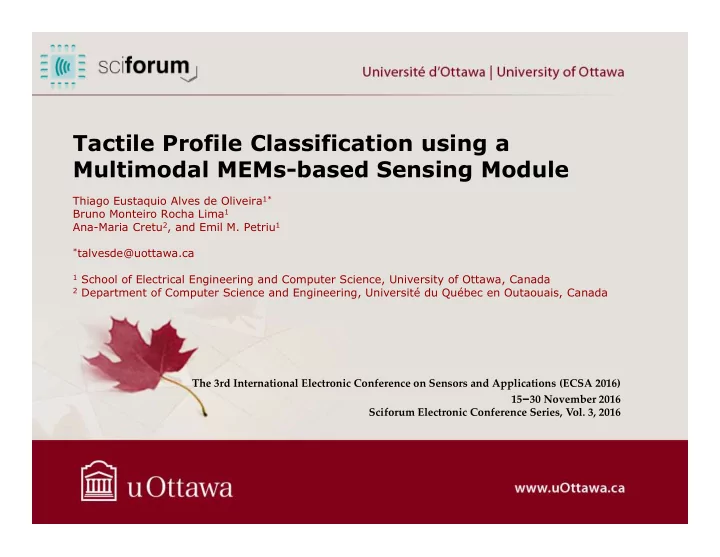

Tactile Profile Classification using a Multimodal MEMs-based Sensing Module Thiago Eustaquio Alves de Oliveira 1* Bruno Monteiro Rocha Lima 1 Ana-Maria Cretu 2 , and Emil M. Petriu 1 * talvesde@uottawa.ca 1 School of Electrical Engineering and Computer Science, University of Ottawa, Canada 2 Department of Computer Science and Engineering, Université du Québec en Outaouais, Canada The 3rd International Electronic Conference on Sensors and Applications (ECSA 2016) 15 – 30 November 2016 Sciforum Electronic Conference Series, Vol. 3, 2016
Outline • Introduction • Literature Review • Our approach • Experimental setup • Results • References
Introduction • Recognition of objects by touch is one of the first steps to enable robots to help humans in everyday activities. • Many applications such as health and elder care, manufacturing, and high-risk environments involve tasks that require robots to handle objects that are out of their field of view or partially obstructed. • Object recognition by touch can be divided in recognition through static or dynamic touch. – In static touch recognition, the tactile sensing apparatus establishes contact with an object and collects tactile data while the object is still related to the probe. – In the recognition through dynamic touch, the tactile apparatus gathers data while the sensors slide over the object’s surface.
Our approach • This paper focuses on the issue of tactile profile recognition through a sliding motion performed by a robot finger comprises 3 motors equipped with a tactile probe. • The tactile probe comprises a 9-DOF MEMs MARG (Magnetic, Angular Rate, and Gravity) system and deep MEMs pressure (barometer) sensor, both embedded in a compliant structure. • This setup collects data over seven 3D printed profiles. • The data collected is then subjected to a wavelet decomposition stage, principal component analysis and classification using a multilayer perceptron neural network.
Our approach Wavelet Acceleration decomposition Angular Velocity Principal Magnetic Field Pressure Component 5 th approx. level Analysis Multilayer Perceptron 90% of PCs Classification Shape Number
Experimental setup
Sensor placement
Shapes used in the experiment
Pressure output Shape 1 Shape 2 Shape 3 Shape 7 Pressure Sample Output number Discrete Time (t) Shape 4 Shape 5 Shape 6
Results Classification results according to sensor type . Sensor Accuracy (%) Accelerometer X 92 Accelerometer Y 92.6 Accelerometer Z 85.1 Gyroscope X 98.3 Gyroscope Y 93.3 Gyroscope Z 98.9 Magnetometer X 88 Magnetometer Y 86.9 Magnetometer Z 91.4 Barometer 98.9
Results: Confusion tables
References 1. Dahiya, R. S.; Mittendorfer, P.; Valle, M.; Cheng, G.; Lumelsky, V. J. Directions toward effective utilization of tactile skin: A review. IEEE Sens. J. 2013, 13 , 4121–4138. 2. Chathuranga, D. S.; Ho, V. A.; Hirai, S. Investigation of a biomimetic fingertip’s ability to discriminate fabrics based on surface textures. 2013 IEEE/ASME Int. Conf. Adv. Intell. Mechatronics Mechatronics Hum. Wellbeing, AIM 2013 2013, 1667–1674. 3. Chathuranga, D. S.; Wang, Z.; Ho, V. A.; Mitani, A.; Hirai, S. A biomimetic soft fingertip applicable to haptic feedback systems for texture identification. In 2013 IEEE International Symposium on Haptic Audio Visual Environments and Games (HAVE) ; IEEE, 2013; pp. 29–33. 4. Dallaire, P.; Emond, D.; Giguere, P.; Chaib-Draa, B. Artificial tactile perception for surface identification using a triple axis accelerometer probe. In 2011 IEEE International Symposium on Robotic and Sensors Environments (ROSE) ; IEEE, 2011; pp. 101–106. 5. Mallat, S. G. A Theory for Multiresolution Signal Decomposition: The Wavelet Representation. IEEE Trans. Pattern Anal. Mach. Intell. 1989, 11 , 674–693. 6. Bro, R.; Smilde, A. K. Principal component analysis. Anal. Methods 2014, 6 , 2812. 7. Møller, M. F. A scaled conjugate gradient algorithm for fast supervised learning. Neural Networks 1993, 6 , 525–533.
Recommend
More recommend